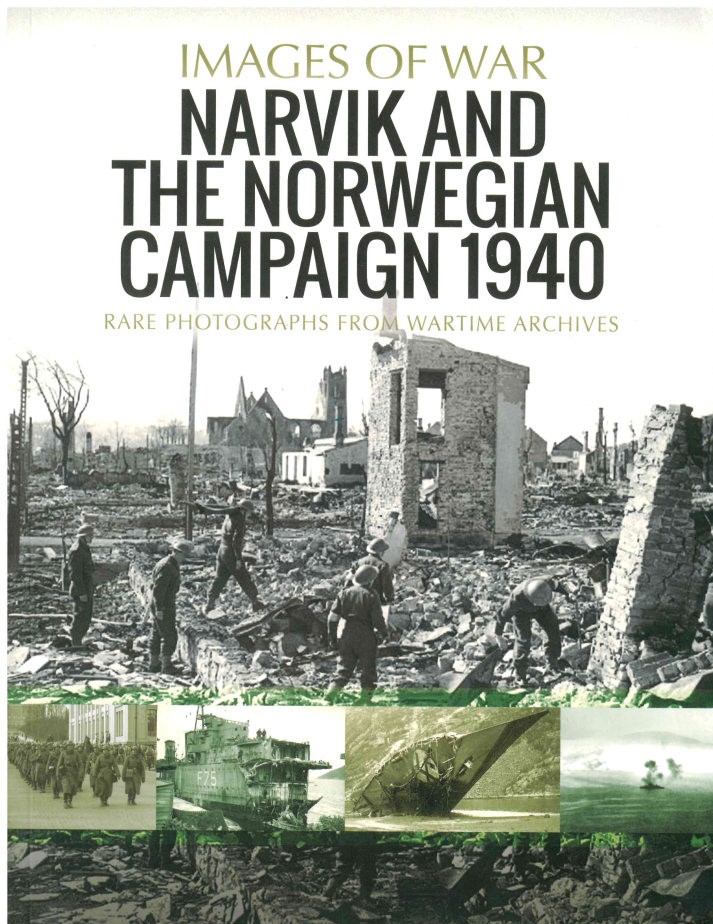Narvik and the Norwegian Campaign 1940
Operation Studie Nord, the German plan for the invasion of Scandinavia was further developed into two separate plans that were to run concurrently – Weserubung (River Exercise) and Weserubung Sud (River Exercise South) for Norway and Denmark, respectively. The plans were drawn up after Germany’s invasion of Poland and during the “Phoney War” (Queen’s English as the book’s author is English). This often-overlooked campaign violated both Denmark and Norway’s neutrality before the German military campaign against France and the Low Countries and took place shortly after the Russian-Finish Winter War of 1939-1940. Besides Denmark and Sweden being neutral, both countries’ monarchs were brothers. The similarities between both countries continued with relatively low numerical military strength and modern weapons; the difference was how the countries chose to respond. This excellent photographic book focuses on the campaign in Norway, with a lead up and summary of the events leading to the very short German campaign in Denmark.
While the Germans wanted to absorb Norway into their sphere, they were primarily focused on the northern Norwegian ice-free port of Narvik to transport war critical iron ore from Sweden. Thus set the stage for the relatively brief, violent, and harsh conditions fighting on the sea, air, and land between German forces and those of Norway, Great Britain, France, and Polish Navy and Army units serving in French formations. While this is not a definitive account of the campaign, it is well broken into 14 easy to understand chapters (see the table of contents attached) with a fantastic collection of photographs illustrating the campaign unfold.
As was the case for most of the early European World War II campaigns, the allies who stood up to the German onslaught were not adequately prepared. This campaign also proved the Germans weren’t prepared for the fight, and both sides learned valuable lessons that would have ramifications throughout the rest of the war.
Both allies and Germans fought to their advantage and tried to mitigate their weaknesses; for the British, they used their naval forces extensively, while the Germans relied on their Luftwaffe. While Norway was initially neutral, the British struck first by mining the many Norwegian ports. The Norwegians were furious at the British attack on their neutrality, but reversed course quickly when the Germans invaded shortly thereafter. Sea transport for the Germans was limited as they had no purpose designed amphibious or assault craft. What unfolded was a German attack into Oslo as British and French troops landed in central Norway and attempted to block the Germans moving north. Lacking heavy weapons and land transportation (that were either left on the dock or not loaded properly in sequence to be used), the allies could do little to assist the exhausted and numerically inferior Norwegian forces to stem the German onslaught, especially given German air superiority.
The harsh terrain and weather fought both sides as they wrestled for the control of Norway. There were battles on the sea, land, and air in which both sides learned valuable skills. Each chapter begins with a brief one-to-two-page synopsis, followed by several pages of photographs highlighting the chapter through the lenses of the troops who fought. The campaign was doomed from the start as the allies sought to stem the German tide. There were a few opportunities for the allies to take the initiative, but the overall campaign became a side water for the larger campaign for France that was fought, and lost, during the Norwegian campaign. The French soldiers were evacuated to Britain.
The talented author writes in the Queen’s English and can be a little confusing at times for non-British readers (dates for example are day, month, year, spelling, etc), but that is an easy obstacle to overcome. The one thing that would really compliment this book is more maps of the actions referenced in the text and photographs. There is one map of Norway with the major locations and events on page 6, but maps throughout the text with movements and major events would go a long way. The author does due diligence and has some great quotes, like this one on page 195, “Macksey, the British commander, now favored a ‘scientific encirclement’ followed by an eventual assault.” As a retired soldier, I have no idea what that means, but it is intriguing and makes one wonder.
This book is a great easy-to-read introduction to the Norwegian campaign and really fills in the gap between the “Phoney War” and the continuation of the Blitzkrieg. I have learned a lot about this campaign, as did the combatants, especially regarding landing operations, devastating naval losses, air power and gaining air superiority and the stark realization that this war was not going to be a continuation of the Great War a generation earlier.
For modelers, there are a plethora of amazing, detailed photos of naval craft, aircraft, tanks, artillery, machine guns and combatants from Germany, England, France, Poland, Denmark and Norway. There is a lot of inspiration for models, vignettes and dioramas in this book, especially for any modelers who wish to highlight the harsh conditions encountered.
Profuse thanks to Casemate (https://www.casematepublishers.com) and IPMS/USA for providing the review sample.



















Comments
Add new comment
This site is protected by reCAPTCHA and the Google Privacy Policy and Terms of Service apply.
Similar Reviews